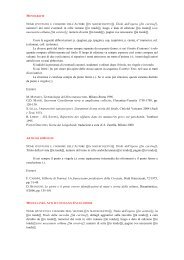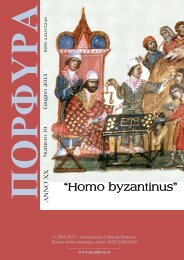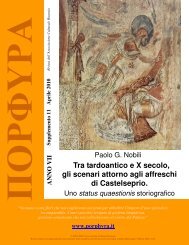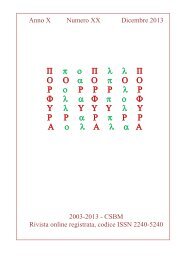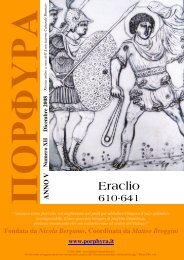ΠΟΡΦΥΡΑ - Porphyra
ΠΟΡΦΥΡΑ - Porphyra
ΠΟΡΦΥΡΑ - Porphyra
Create successful ePaper yourself
Turn your PDF publications into a flip-book with our unique Google optimized e-Paper software.
A Prôtospatharios, Magistros, and Strategos Autokrator of 11 th cent.<br />
the equipment of Georgios Maniakes and his army according to the Skylitzes Matritensis miniatures<br />
and other artistic sources of the middle Byzantine period.<br />
concept should not be regarded as absolute. There is, in my<br />
opinion, many elements which show completely the opposite,<br />
i.e. that the East-Roman artists, throughout the 12 centuries of<br />
the Byzantine history even if following some conventions,<br />
represented in their works military figures which they saw with<br />
their own eyes. There is even the possibility that they based<br />
their works on cartoons or drawings which depicted real figures,<br />
or historical events illustrated in earlier paintings executed at the<br />
time of the actual event.<br />
From a general point of view, the East-Roman artist was<br />
a realist who had to represent a specific character, or some event<br />
in history which followed the directives bestowed by his patron.<br />
In such representations he adapted the fashions of the age in<br />
which he lived and represented characters and figures as they<br />
came in to view or as the iconographic tradition dictated that<br />
they appear. But while this last element was essential for the<br />
major characters of the Church and of the life of Christ, because<br />
nobody would have accepted Saint Peter dressed in 10th century<br />
fashion or depicted Saint Paul dressed like a priest of the 11th<br />
century, the entourage who often surrounded such personages<br />
were taken from contemporary life. These would have included<br />
representations of peasants, women, priests, houses and<br />
Churches and I do not see why soldiers should have been<br />
considered as a separate category. Therefore in my opinion they<br />
are represented within conventional outlines but which does<br />
not exclude an element of reality.<br />
It is important however to consider the problems of<br />
artistic convention and stylisation. It is obviously artistic<br />
convention not coincidence that on the Great Trajanic Freeze of<br />
the Constantine Arch, the Emperor Trajan is represented in the<br />
same position as Alexander the Great in the Issos mosaic 30 .<br />
Trajan charges the enemy with his spear, in the same way as the<br />
Great Macedonian, and rides a horse whose harness echoes<br />
those of Bukefalos. Nobody would contest however that in the<br />
Issos Mosaic Alexander is dressed as a Senior Macedonian<br />
Cavalry Officer of 3rd century B.C., or that in the Trajanic<br />
Freeze Trajan is dressed as a Roman Emperor of the 2nd century<br />
AD. Some figurative outlines in the ancient World and middle<br />
Age art of Byzantium were used and applied for different<br />
personages of different ages, but it does not preclude the<br />
possibility that artists represented the reality of their own age.<br />
Numerous elements of arms and armour, as well as<br />
military clothing mentioned in literary sources are corresponded<br />
in the artistic works of the period, as we will highlight in this<br />
article. I do not see any reason to deny the value of evidence of<br />
the ancient artistic sources when it comes to the reconstruction<br />
of East-Roman military equipment. This is even more true when<br />
the representations of the artist was an official one, i.e. when the<br />
30 Cf. Touati A.M. L., The Great Trajanic Frieze, Stockholm 1987, p. 40 and pl. 2, 11.<br />
6



